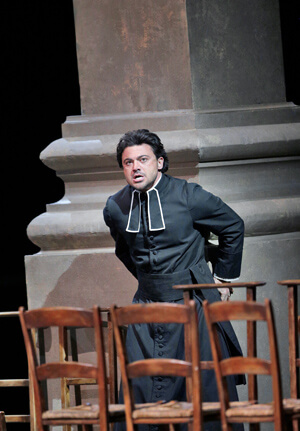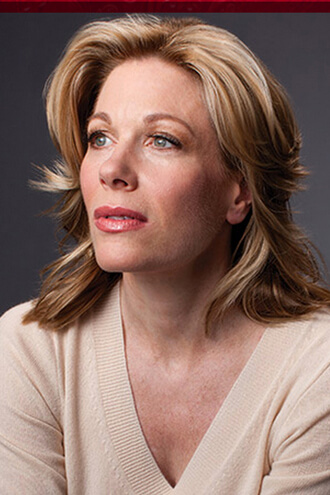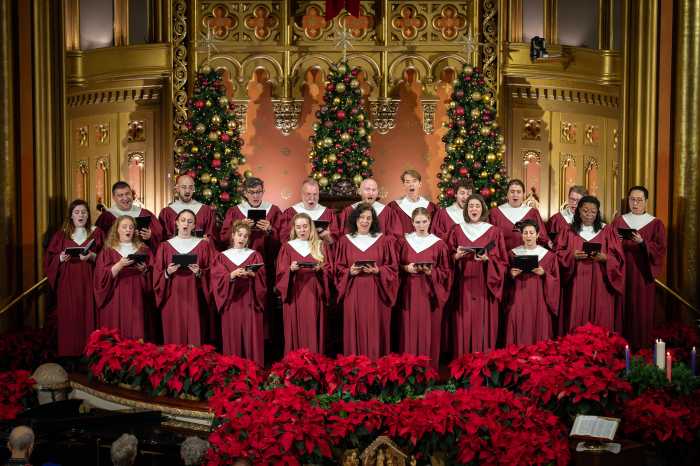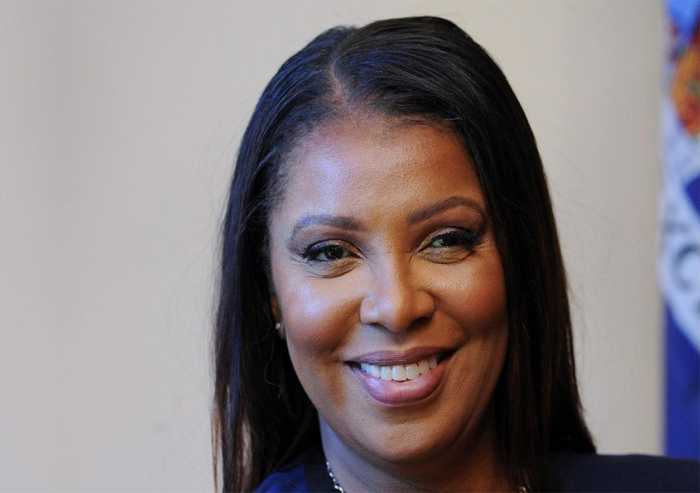Liudmyla Monastryska and PlaÌcido Domingo in Verdi's “Nabucco.” | MARTY SOHL/ METROPOLITAN OPERA
As far back as Biblical times, the Middle East region has been a cauldron of tribal warfare and power struggles. These conflicts also figured in the historical background behind the Christmas and Hanukkah holidays we celebrate this month. Opera also has its share of Mideast conflicts, as witnessed on local opera stages in November and December.
Racial and religious conflicts in ancient Jerusalem and Babylon provide the backdrop for Verdi’s “Nabucco” which opened at the Metropolitan Opera on December 12. Plácido Domingo and James Levine, two legendary operatic lions in winter, reunited as the titular tyrant and maestro in charge.
When dealing with latter-day Domingo as baritone, one either concentrates on what he has or on what he hasn’t. No, he hasn’t the deeper resonances or tonal weight of a true baritone – low-voiced declamation requires little glottal grunts because Domingo can’t expand the tone down there. Occasionally, note values within a phrase sound improvisational. What is still there is a slightly worn but still attractive warm timbre, impressive volume, a flowing legato line, and a commanding, energetic stage persona unusual for a performer over 70. His Babylonian king has the authority of a born ruler and pathos in defeat. In this instance, the cup was much more than half full.
“Nabucco,” “Salome” on the Met stage this season; “Fallujah” at New York City Opera
Levine was not quite the firebrand in the pit he was when this production premiered in 2001. But he conducted with point, clarity and control utilizing precise, energetic gestures.
As the witchy, bitchy Abigaille, dramatic soprano Liudmyla Monastyrska had lots of attractive tone everywhere except for skimping chest tone on the low end. Her soprano took on a particularly voluptuous sheen in broad expansive phrases (one longs for her “Forza” Leonora and Amelia in “Ballo”). It is not a quick-moving voice and some of the rollercoaster runs were approximated and her second act cabaletta was trill-less. Monastyrska still tends to drop consonants and sing mushy homogenized vowels. However, one should not quibble with such effortless generosity of tone and volume, and Monastyrska revealed some feisty diva attitude absent from her impeccably vocalized Aida.
Fellow Ukrainian Dmitry Belosselskiy was a rich-toned, imposing Zaccaria except for one or two of the lowest notes for which he had to take higher options. Luxury casting extended to the supporting roles of Fenena and Ismaele – Russell Thomas as Ismaele sang with a burnished, ringing tenor, and Jamie Barton in Fenena’s Act IV solo provided the best solo singing of the evening.
Donald Palumbo’s chorus once again had to repeat “Va Pensiero” after a deserved ovation. A near capacity audience (unusual at the Met these days) enjoyed what they saw and heard.
You can see and hear and enjoy “Nabucco” in HD on Saturday, January 7 at 12:55 p.m. (metopera.org/Season/In-Cinemas).
Patricia Racette in the tile role of Strauss' “Salome” at the Metropolitan Opera. | KEN HOWARD/ METROPOLITAN OPERA
Strauss’ “Salome,” set in first century Judaea, returned to the Met on December 5 after a long absence. Jürgen Flimm’s 2004 production is updated to resemble the outdoor patio of a Dubai resort hotel sometime in the 20th century. Patricia Racette replaced Catherine Naglestad in the title role, while Željko Lucic squared off against her as the prophet Jokanaan. Both artists were singing their first German roles at the Metropolitan.
Tenor Gerhard Siegel was an amusingly neurotic Herod, finding manic humor in the despot’s paranoia. His concentrated tone combines the theatrical personality of a character tenor with the tonal thrust of a heldentenor. Nancy Fabiola Herrera’s rich-toned vituperative Queen Herodias resembled a dissipated Gale Sondergaard who becomes increasingly inebriated as the evening wears on. Kang Wang’s bright tenor blazed briefly as Narraboth in his Met debut. Met debutant Johannes Debus conducted a transparent, lyrical French impressionist reading of the score that accommodated a less than Wagnerian leading soprano. This was the closest I’ve heard in this score to Strauss’ famous request that his music be treated like “Mendelssohn fairy music,” but the element of sinister darkness was absent.
Racette and Lucic have become problematic for me in their usual Italian repertoire but seemed better suited to German opera at this point in their careers. Lucic’s foggy recessed tone and morose stage demeanor lack the vibrancy for Verdi baritone assignments. As Jokanaan, his hollow timbre and introverted manner suited a prophet of doom. Lucic produced huge volume – high notes can sag flat but this was a convincing assumption overall.
After more than 25 years on the operatic stage and several testing spinto assignments, Racette’s firm full lyric soprano has taken on a hard glassy edge. In the title role, she exceeded expectations and earned admiration without crossing the line into that mixture of amazement and revulsion a great Salome should evoke. This Judean princess was a knowing, sexually manipulative film noir vixen in a low-cut white silk evening gown – think Jane Greer in “Out of the Past.” The metallic edge on her mature soprano, so jarring in Puccini, turned into a penetrating brilliance in Strauss that cut through the dense orchestration. High notes were secure but could be opaque with a slight beat.
The only two strong vocal demerits were weak low notes (this is where the Wagnerian Salomes deliver more tone) and the lack of a true piano, which could have provided a touch of otherworldly weirdness and spoiled innocence to the character. Racette has worked out every moment, projecting specific meaning into the text. Her “Dance of the Seven Veils” showed that she is not a dancer, and her voluptuously rounded figure fully exposed is not that of a 16-year-old virgin. She paced herself cannily, maintaining stamina and freshness through an effective final scene. But Racette’s voice is reliable and musical without being stunningly beautiful or powerful, and her interpretation was intelligent without crossing over into the demented. A less than demented Salome makes for a less than memorable “Salom.”
Arnold Livingston Geis and Lamrcus Miller in Tobin Stokes' “Fallujah.” | SARAH SHATZ/ NYC OPERA
New York City Opera presented four performances of Tobin Stokes’ chamber opera “Fallujah” over the course of a long weekend in mid-November. The work was commissioned by Charles Annenberg Weingarten, had a 2012 workshop in Vancouver, and received its world premiere at Long Beach Opera in March 2016.
The NYCO imported the Long Beach production largely intact for its New York premiere at the Duke on 42nd Street. The libretto concerns the still tragically relevant issue of Iraq war veterans suffering from post-traumatic stress disorder. The opera is based on the personal story of US Marine Sergeant (ret.) Christian Ellis, who was discharged from Iraq in 2004. Librettist Heather Raffo, an Iraqi-American, has constructed a taut and moving libretto which clearly states that war, justified or not, is a tragedy that destroys the bodies and souls of both soldiers and civilians in the war zone.
In this 90 minute one-act opera, USMC Lance Corporal Philip Houston (a composite of Ellis and other mentally scarred veterans, sung with commitment by LaMarcus Miller) is hospitalized after his third suicide attempt. He flashes back to tortured memories of his interactions between an Iraqi mother and son and his fellow marines in the beleaguered city of Fallujah, the site of a particularly bloody battle fought in a densely populated settlement.
Outside his room, his adoptive mother, Colleen (the moving soprano Suzan Hanson), tries to reconnect with him but he will not see her. Raffo’s libretto humanizes both the Iraqi citizens and the US military personnel fighting a war in a country where at any moment they could be the victim or victimizer for reasons they do not understand. The suffering resonates through the families of the soldiers – even those who survive the war.
Ani Maldjian and Jonathan Lacayo as the doomed Iraqi mother and son were heartbreaking. Director and production designer Andreas Mitisek’s staging expertly used video projections by Hana S. Kim to seamlessly take us into the ruined landscape of Fallujah, which is continually revisited in Houston’s mind.
Tobin Stokes’ score – using a dozen musicians led authoritatively by Kristof Van Grysperre – synthesizes Middle Eastern idioms, rock (Stokes began as a rock drummer and jazz pianist), and minimalism. In the context of the staging and story, Stokes’ score works brilliantly as a soundtrack for Houston’s inner journey to healing (if not peace) but may not achieve distinction on its own as a standalone musical composition.
Iraq veterans Michael Hebert and Jon Harguindeguy, who worked as art designers/ consultants on this production, spoke movingly at the post-performance talk on how working on the opera helped them overcome their own PTSD through art therapy. This is a worthwhile music theater work with a topical story ripped from the headlines. This opera touched the souls of the performers and audiences deeply. “Fallujah” deserves greater attention and can be viewed online here: explore.org/videos/player/fallujah-opera.




















